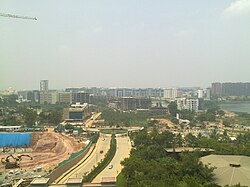Whitefield, Bangalore
| Whitefield, Bengaluru ವೈಟ್ಫೀಲ್ಡ್, ಬೆಂಗಳೂರು |
|
|---|---|
| Neighbourhood | |

A view of EPIP Zone, Whitefield
|
|
| Coordinates: 12°58′N 77°45′E / 12.97°N 77.75°ECoordinates: 12°58′N 77°45′E / 12.97°N 77.75°E | |
| Country | India |
| State | Karnataka |
| Metro | Bengaluru |
| Government | |
| • Body | BBMP |
| Languages | |
| • Official | Kannada |
| Time zone | IST (UTC+5:30) |
| Postal Index Number | 560066 |
| Vehicle registration | KA-53 |
Whitefield is a neighborhood of Bengaluru in the state of Karnataka, India. Established in the late 1800s as a settlement for the Eurasians and Anglo Indians of Bangalore, Whitefield remained a quaint little settlement at the eastern periphery of Bangalore city till the late 1990s when the local IT boom turned it as a major suburb. It is now a major part of Greater Bangalore. It is renowned for Sathya Sai Baba's ashram called Brindavan and as a haven for multinational information technology companies.
On 27 April 1882, Chamaraja Wodeyar IX, the Maharaja of Mysore State, granted 3,900 acres (16 km2) of land to the Eurasian and Anglo-Indian Association, Mysore and Coorg (E&AI) for the establishment of agricultural settlements at Whitefield, which lay within his territory. The association was then about 170 strong with a committee of 30 members. They were part of the formation of the only settlement in India that European and Eurasians could call their own. David Emmanuel Starkenburgh White, the then president of the E&AI Association, South India Ltd., took a lively interest in it and helped in its advancement which at the beginning was an uphill task.
In the first decade of the 1900s there were about 45 houses: 18 were on the village site and the remainder were on farms throughout the settlement and contained about 2,000 acres (8.1 km2) of land fit for cultivation. The number of residents in 1907 was 130. Lord Connemara, the then governor of Madras (1890) and General Sir Harry Prendergast, a British resident in Mysore, visited the settlement and lent support to the development of Whitefield. Subsequently, there were regular visits to Whitefield by the Bangalore District officials and high dignitaries from the Madras Presidency.
The settlement was 3 kilometres (1.9 mi) south of the Bangalore-Madras (now Chennai) line and a station was built. It led to the influx of residents and their families who worked at Kolar Gold Fields, about 50 kilometres (31 mi) (by train) to the east. It became convenient for those working at KGF to catch a train (running 3 to 4 times a day) and return to their families. There were frequent trains running to Bangalore 20 kilometres (12 mi) to the west (by train). Reaching the settlement from the railway station was possible only by writing a letter to Mrs. Hamilton (wife of a James Hamilton, the keeper of the Waverly Inn) who would arrange for a bullock cart trip for 8 annas.
...
Wikipedia
